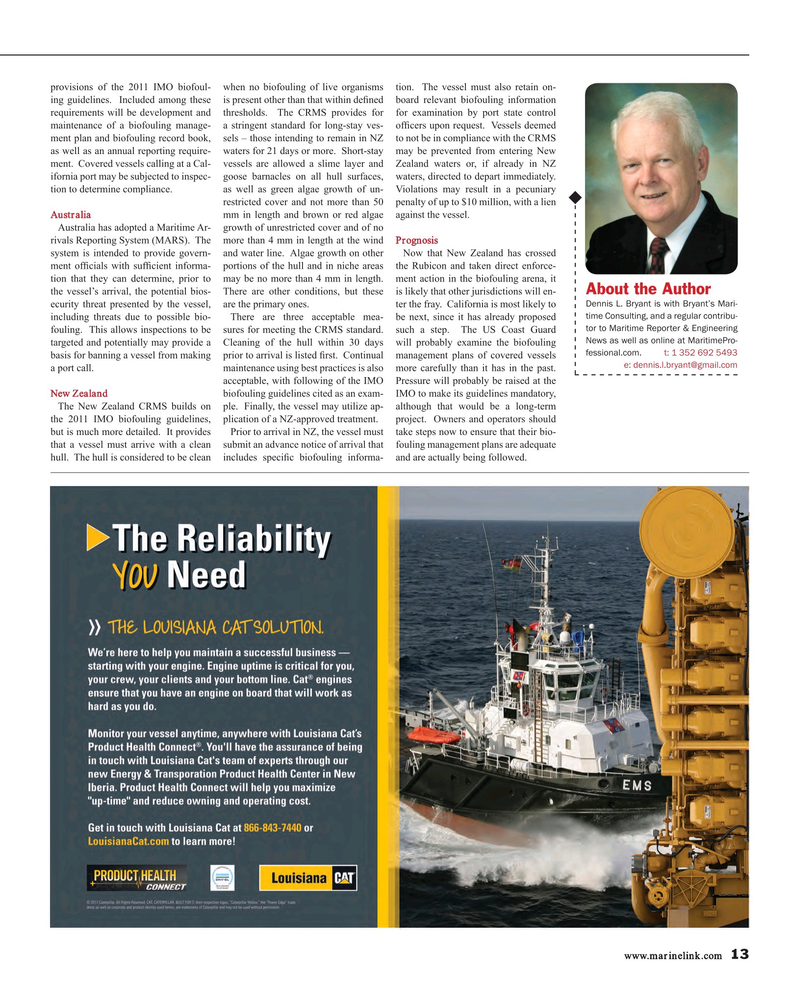
Page 13: of Maritime Reporter Magazine (May 2017)
The Marine Propulsion Edition
Read this page in Pdf, Flash or Html5 edition of May 2017 Maritime Reporter Magazine
provisions of the 2011 IMO biofoul- when no biofouling of live organisms tion. The vessel must also retain on- ing guidelines. Included among these is present other than that within de? ned board relevant biofouling information requirements will be development and thresholds. The CRMS provides for for examination by port state control maintenance of a biofouling manage- a stringent standard for long-stay ves- of? cers upon request. Vessels deemed ment plan and biofouling record book, sels – those intending to remain in NZ to not be in compliance with the CRMS as well as an annual reporting require- waters for 21 days or more. Short-stay may be prevented from entering New ment. Covered vessels calling at a Cal- vessels are allowed a slime layer and Zealand waters or, if already in NZ ifornia port may be subjected to inspec- goose barnacles on all hull surfaces, waters, directed to depart immediately. tion to determine compliance. as well as green algae growth of un- Violations may result in a pecuniary restricted cover and not more than 50 penalty of up to $10 million, with a lien
Australia mm in length and brown or red algae against the vessel.
Australia has adopted a Maritime Ar- growth of unrestricted cover and of no rivals Reporting System (MARS). The more than 4 mm in length at the wind Prognosis system is intended to provide govern- and water line. Algae growth on other Now that New Zealand has crossed ment of? cials with suf? cient informa- portions of the hull and in niche areas the Rubicon and taken direct enforce- tion that they can determine, prior to may be no more than 4 mm in length. ment action in the biofouling arena, it
About the Author the vessel’s arrival, the potential bios- There are other conditions, but these is likely that other jurisdictions will en-
Dennis L. Bryant is with Bryant’s Mari- ecurity threat presented by the vessel, are the primary ones. ter the fray. California is most likely to time Consulting, and a regular contribu- including threats due to possible bio- There are three acceptable mea- be next, since it has already proposed tor to Maritime Reporter & Engineering fouling. This allows inspections to be sures for meeting the CRMS standard. such a step. The US Coast Guard
News as well as online at MaritimePro- targeted and potentially may provide a Cleaning of the hull within 30 days will probably examine the biofouling fessional.com. t: 1 352 692 5493 basis for banning a vessel from making prior to arrival is listed ? rst. Continual management plans of covered vessels e: [email protected] a port call. maintenance using best practices is also more carefully than it has in the past. acceptable, with following of the IMO Pressure will probably be raised at the
New Zealand biofouling guidelines cited as an exam- IMO to make its guidelines mandatory,
The New Zealand CRMS builds on ple. Finally, the vessel may utilize ap- although that would be a long-term the 2011 IMO biofouling guidelines, plication of a NZ-approved treatment. project. Owners and operators should but is much more detailed. It provides Prior to arrival in NZ, the vessel must take steps now to ensure that their bio- that a vessel must arrive with a clean submit an advance notice of arrival that fouling management plans are adequate hull. The hull is considered to be clean includes speci? c biofouling informa- and are actually being followed.
www.marinelink.com 13
MR #5 (10-17).indd 13 MR #5 (10-17).indd 13 5/3/2017 7:55:33 PM5/3/2017 7:55:33 PM

 12
12

 14
14
